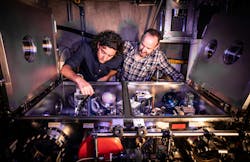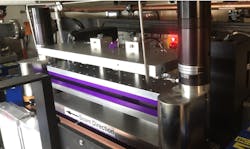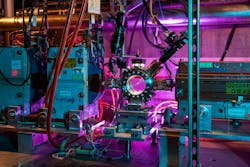SLAC scientists create world’s most powerful ultrashort electron beam
Laser Focus World: What inspired your work to create the world’s most powerful ultrashort electron beam?
Claudio Emma, staff scientist, SLAC National Accelerator Laboratory: Electron beams are formidable probes of the natural world, and the more powerful the electron beams we can create the broader the set of phenomena we can shed light on and understand in the lab. Creating higher current, more powerful electron bunches was recently recognized by the U.S. Department of Energy in 2022 as one of four ‘grand challenges’ for particle accelerator physics. This inspired us to tackle this challenge at FACET-II, which is a facility at SLAC that was designed specifically to do this kind of research on extreme beam manipulation.
LFW: Can you describe the basic concepts and design work involved?
Nathan Majernik, associate scientist, SLAC National Accelerator Laboratory: The laser heater works by copropagating the electron beam with a laser beam through a periodic array of magnets called an ‘undulator.’ The magnets alternate in polarity, north-south-north-south, which causes the electrons to wiggle side-to-side as they move down the length of the undulator. By picking the period of this wiggling to be resonant with the laser wavelength, we can add or remove energy from the electrons with the laser each time they wiggle back and forth; basically, the transverse electromagnetic (EM) fields of the laser can give a nudge to the electrons that can build up over time. This is the same concept used at free electron lasers like at SLAC’s Linac Coherent Light Source (LCLS)—except running in reverse. By controlling the temporal profile of the laser, we can selectively modify different parts of the electron beam.
LFW: What’s your setup involve?
Emma: The setup for this experiment involves using the laser heater to shape the electron bunch profile with millimeter-scale precision in the first 10 meters of our accelerator when the beam is at low energy. We then take this millimeter-scale modulated electron beam, boost its energy by a factor of 100 in a kilometer-long stretch of downstream accelerating cavities, and compress it by a factor of 1000 using magnets to turn the millimeter-scale features into a micrometer-long current spike.
The real trick is to optimize the laser-based modulation of the beam in tandem with the accelerating cavity and magnetic fields of the magnets to get the optimally compressed beam at the end of your accelerator.
LFW: Most surprising/coolest aspects of your work?
Kelly Swanson, project scientist, SLAC National Accelerator Laboratory: One of the most exciting parts of this research is the technique’s versatility and the potential for future applications. By controlling the laser as we demonstrated, we can create these extremely short, very powerful electron beams. Extending this idea, if we shape the laser in a different pattern we can create more complex structures in the beam such as a train of short electron pulses. Moreover, we can use this technique in reverse! Sometimes the electrons naturally bunch together in ways that can be detrimental to a particular experiment, but we can smooth out this unwanted structure by adjusting how the laser interacts with the beam. The sensitivity to the shape of the laser opens doors to exciting new possibilities.
LFW: Any big challenges to overcome? Anything special about materials or scaling?
Emma: The main challenge we faced was to carefully optimize and control the generation of these beams, which involves balancing the laser-based modulation strength, the downstream acceleration of the beam, and the magnet settings. This process requires navigating a large parameter space with numerous adjustments and careful iteration to find the optimal configuration. Another challenge is measuring the peak current of these ultrashort bunches. They are typically so intense that intercepting them with materials like scintillating screens (commonly used in accelerators to diagnose beam properties such as spot size or bunch length) can result in the beam fields being so strong that they melt the screens. To overcome this, we had to use a series of indirect measurements (plasma ionization, beam-based radiation) along with simulations to accurately diagnose the degree of compression and power of these beams.
LFW: Applications? Quantum? Timeline to use?
Swanson: The controlled generation of very short, very dense electron beams opens exciting avenues for research. If we were to send these beams through an undulator similar to the one used in the laser heater, they would produce intense bursts of x-rays on the timescale of atomic and molecular processes. With these x-rays, we can study chemical reactions, properties of novel materials, and other ultrafast dynamics that cannot easily be probed otherwise. Alternatively, we can collide these beams with an intense laser to study the strong-field regime of quantum electrodynamics, which explains some phenomena occurring in the vacuum of space at a quantum level as well as within extreme environments like neutron stars or near black holes.
We’re excited that these beams are already contributing to experiments at FACET-II and having a meaningful impact. When these beams travel through a gas, they efficiently ionize it to create a plasma inside which additional electrons can be accelerated to high energies. This method, called plasma wakefield acceleration, has the potential to significantly reduce the size and cost of particle accelerators, making research facilities more accessible and enabling new applications ranging from high-energy physics to medical therapies. The enhanced ability to ionize using these powerful beams not only improves stability in the acceleration process but allows for greater customization to suit different applications.
LFW: What’s next?
Majernik: Our present approach to the spectrotemporal masking of the laser heater profile is ‘artisanal’ in nature, carefully shaping the beam for a particular application. We’re excited about improving the masking process, for example with a digital micromirror device, allowing for precise and rapid control of the profile.
Emma: Looking further ahead, we aim to increase the beam current by another order of magnitude to produce megaampere beams. Achieving this significant advancement will require employing a different plasma-based compression technique instead of the current laser-based method. We’re currently installing new hardware that will enable us to demonstrate this plasma-based compression technique at FACET-II, and we hope to share those exciting results in the near future.
FURTHER READING
C. Emma et al., Phys. Rev. Lett., 134, 085001 (Feb. 27, 2025); https://doi.org/10.1103/physrevlett.134.085001.


